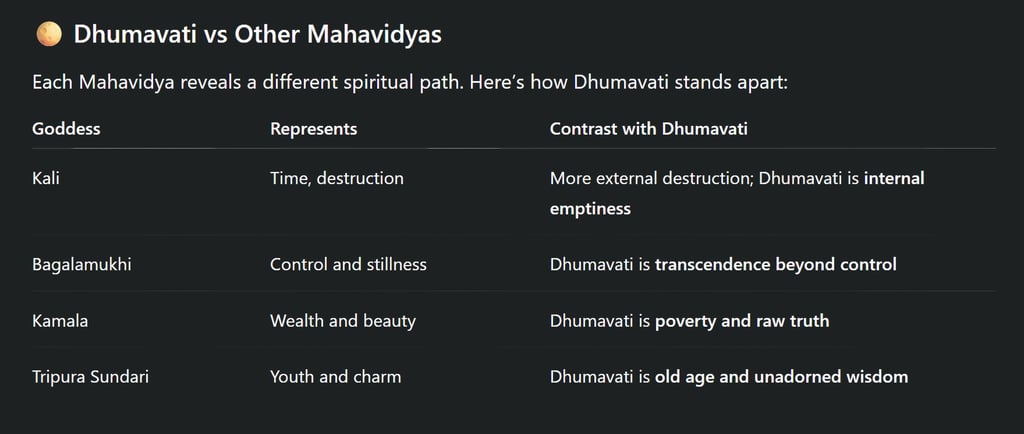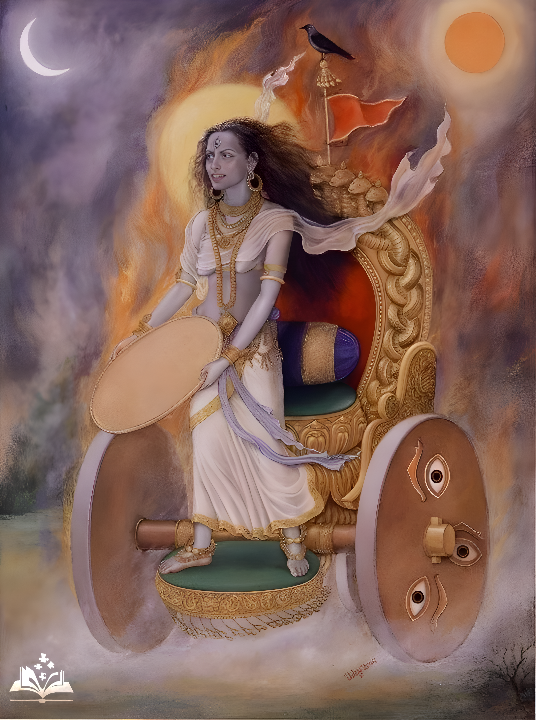
Dhumavati Jayanti: The Sacred Day of the Smoky Goddess of Wisdom and Renunciation
Discover the significance, rituals, symbolism, and spiritual wisdom of Dhumavati Jayanti—honoring the fierce goddess of sorrow, renunciation, and inner truth.
CULTURE/TRADITIONEVENT/SPECIALINDIA/BHARATCELEBRATION/FESTIVALS
Keshav Jha
5/31/20253 min read


Dhumavati Jayanti (धूमावती जयंती) is a significant Hindu observance dedicated to Mata Dhumavati, the seventh form among the ten Mahavidyas, who represents the smoky, widow form of the Divine Mother. Observed on the Krishna Ashtami (eighth day of the waning moon) during the month of Jyeshtha (May–June), the day marks her divine manifestation—an embodiment of loss, solitude, renunciation, and unvarnished truth.
Rather than representing fertility or abundance, Dhumavati represents what comes after destruction—the wisdom that follows loss, the truths uncovered by time, and the spiritual power born of suffering.
Historical & Scriptural References
Though not as widely discussed in mainstream Hinduism as other goddesses, Dhumavati holds a crucial role in Shakta Tantra texts, such as
Rudra Yamala Tantra
Tantrasara
Devi Bhagavatam
According to one tale in the Pranatoshini Tantra, Dhumavati emerged when Sati, hungry and ignored, swallowed Shiv Ji out of anger. Shiv Ji requested her to return him, and she complied. He then cursed her to take the form of a widow and live as an outcast. From this myth emerges a goddess untethered from societal expectations, revered for her raw, elemental energy.
Dhumavati’s Attributes and Iconography
Worship Practices on Dhumavati Jayanti
While Dhumavati is often worshipped by sadhakas (advanced spiritual aspirants) and tantrikas, the day is also quietly observed by common devotees seeking relief from suffering or clarity in dark times.
Common Rituals Include
Observing Vrat (Fast): Devotees undertake nirjala (waterless) or phalahar (fruit-based) fasts.
Mantra Japa:
“ॐ धूं धूं धूमावत्यै नमः”
“Dhoom Dhoom Dhoomavati Thah Thah”
Lighting Mustard Oil Lamps: Symbolizing light in dark times.
Offering Food to Crows: Believed to appease ancestors and the goddess herself.
Meditation and Shadow Work: Observers often spend the day reflecting, journaling, or working through emotional blockages.
Charity and Feeding the Poor: Acts of detachment and service are encouraged.
Regional Observances
Varanasi (Uttar Pradesh): The Dhumavati temple near the Kashi Vishwanath corridor sees tantric rituals and midnight pujas.
Guwahati (Assam): Kamakhya Temple hosts secretive tantric celebrations led by sadhus.
Kolkata (West Bengal): Devotees in Shakta traditions perform homas and chant the Mahavidya stotras.
Nepal and Himalayan Belt: Dhumavati is worshipped alongside the other Mahavidyas in localized traditions, often as a guardian of tantric paths.
Symbolic Meaning in Everyday Life
Though her form may seem intimidating, Dhumavati teaches us to:
Embrace the Void: Accept silence and emptiness not as lack, but as space for new growth.
Detach Mindfully: Let go of toxic relationships, expectations, or material cravings.
Honor Aging and Wisdom: Respect elders and the wisdom time brings, especially in a youth-centric society.
Accept Suffering: Face pain with courage; allow suffering to become a teacher rather than a punishment.


Dhumavati Jayanti 2025 Date & Timings
Date: Thursday, May 22, 2025
Ashtami Tithi Begins: May 21, 2025, at 8:42 PM
Ashtami Tithi Ends: May 22, 2025, at 6:25 PM
Best Time for Worship (Puja Muhurat): Preferably during Brahma Muhurat (early morning) or midnight for tantric practitioners.
Global Relevance Today
In a world grappling with:
Mental health issues
Burnout and loss
Aging anxieties
Fear of being alone
Dhumavati serves as a spiritual archetype for emotional resilience, inner strength, and the courage to face shadows. She encourages us to go inward, reflect, release, and rise wiser.
Dhumavati Jayanti is more than a religious date—it’s a journey into the unknown, a time to sit with silence and celebrate the transformative power of grief, solitude, and wisdom. In a world that hides from sorrow, Dhumavati stands firm—reminding us that even in darkness, there is divine light, and in emptiness, there is ultimate truth.


Subscribe To Our Newsletter
All © Copyright reserved by Accessible-Learning Hub
| Terms & Conditions
Knowledge is power. Learn with Us. 📚


